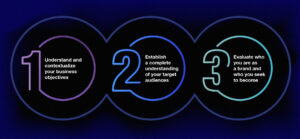This is the third piece in a three-part series about RF|Binder’s new strategic framework: The Clarity Lens™. You can read the first part here and the second part here.
In our previous two posts, we looked at the RF|Binder Clarity Lens™ and what Clarity means within that context. Now, we’ll explore how we bring the Clarity Lens to life.
At the core, the Clarity Lens is a straightforward enough framework – but putting it into practice for your organization will involve bringing together business leaders who might not be used to working closely together, and creating an environment in which they can collaborate meaningfully.
As we’ve discussed already, true “Clarity” isn’t just about speaking directly – it requires a complete understanding of your organization’s business objectives and a meaningful understanding of your target audiences’ wants and needs. Capital-C Clarity requires careful thought as to who you are, what you seek to achieve, who you need to influence, and how best to reach and resonate with your target audiences.
Every organization is different, and it’s critical to account for the culture of your organization when applying the Clarity Lens. But at the highest level, our approach typically follows some basic steps:

First, we look to understand and contextualize your business objectives. This includes understanding your current business drivers, opportunities, areas for expansion, potential threats, and more. It means understanding the true competitive landscape, the public perception of the landscape, and the issues that your customers, potential customers and key influencers care about.
Second, we work to ensure a complete understanding of your target audiences. At RF|Binder, our account teams are deeply immersed in the subject matter of our respective practice areas, and we understand both the industries and the media landscapes that our clients operate in – but some important details can still vary significantly from company to company. For that reason, we always take appropriate steps to fully understand your target audiences – their needs, wants, fears and hopes, as well as any existing perceptions they may have about your organization or about any spaces in which you may have the potential to impact them. Every strategy should be built with an understanding of “what is the essential question that we need to answer for our audience?”
Third, we work to evaluate who you are as a brand, who you seek to become, and how you see your purpose. By establishing a clear understanding of your current and aspirational brand identity and purpose – gleaned through interviews with your leadership and other key stakeholders – we can begin to understand where the most critical work needs to be done, as well as what kind of foundation you have to build upon.
Once you’ve developed your Clarity-focused, business-aligned strategy, it can drive every element of your internal and external communications program – ensuring every communication is always on target, and always driving toward your business objectives. A Clarity-focused strategy empowers your messaging and positioning. It focuses your leadership. And it fuels your connection with stakeholders.
But the Clarity Lens isn’t just useful at the outset of a campaign – it’s also a mechanism for continual improvement and refinement. As your business objectives continue to evolve and grow, so too should your communications strategy. And as your communications team gains deeper insights about certain target audiences or channels, those insights can in turn help to shape a more targeted business strategy.
Ultimately, the Clarity Lens should establish a positive feedback loop that continues to strengthen both your communications strategy and your business strategy moving forward – growing with your business indefinitely.
Interested in applying the Clarity Lens to your brand? Contact us today to get started.

